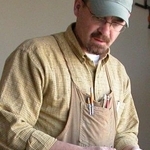I’ve posted recently about my Rikon bandsaw and I’ve finally gotten my upper wheel wobble straightened out. Now that the saw is tuned I’ve found I’m still getting blade reciprocation, but now that everything’s not moving around I can attribute it to the blade. I just got a new Carter blade and it reciprocated over 1/4″. I know it’s the blade because the movement is related to the length of the blade (142″), not the wheel diameter i.e. – it has a high and low spot related to the 142″ measurement. I have some Timber Wolf blades which also reciprocate.
What I’m wondering is if anyone else has differentiated blade movement and attributed it to the blades, not the saw. Has anyone found problems with Timber Wolf or Carter blades?














Replies
That sounds strange to me. How are you determining that your blades have high and low spots?
Although I'm not familiar with Carter blades, I'd expect the Timber Wolf to be dead-on.
blade vs wheel
The blade on this saw is 142" and there was a reciprocation minimum and maximum related to the 142" length which was consistent on each revolution, i.e. - on the same location on the blade on each rotation. The wheels rotate substantially faster having a much smaller radius. Ergo, it's the blade not the wheel. I'd love someone who's a bandsaw expert to tell me otherwise. I am finding that many blades are not as good as they might promise.
It seems to me that the likely spot for a fault in the blade would be the weld. That is, if the blade ends were cut out of square and then welded, that section of the blade would tend to move to and fro, fore and aft, wiggle, or whatever.
You might try finding the weld and put a spot of white paint on it. That should allow you to see the spot in relation to the reciprocation of the blade as it passes the guides. I'd loosen the guides a bit prior to doing the "test" though.
Test Blade Weld
I tore my hair out over this very issue in 2009. I got all kinds of comments but no one suggested checking the blade.
Lay your blade on a smooth surface, teeth away from you so the blade loops up in the air. Put soft weight about 2-3 feet apart with the weld in the middle. Place a straight edge along the edge of the beam. This photo is one of 3 new 3/4" blades I received directly from the distributor. They were all this way, so it is conceivable that an entire production run was bad.
The good thing is it can be repaired in a decent shop. But the manufacturer should send you replacements at no cost and should not ask for the bad blades back unless they compensate for shipping..
And by the way, the band maker who showed me this has his bad days also.
Don
great answer
Don, great reply - thanks. I have indeed torn my hair out on this issue too. I like your method. I had put my blade on a dead flat table, but the results weren't too definitive. I could see blade alignment issues, but gravity was affecting the results. Bandsaw blades deflect too much to be tested in this way. Your method eliminates that problem. I'm going to test my blades your way tonight.
There is an interesting piece to this issue. Generally, blade reciprocation is attributed to the bandsaw (wheel alignment, etc...) and there are numerous articles about tuning and aligning them. However, the FIRST place to look should be the blade. I have never seen this stated. We tend to assume our blades are manufactured correctly, but that faith is misplaced.
Thanks again!
This forum post is now archived. Commenting has been disabled